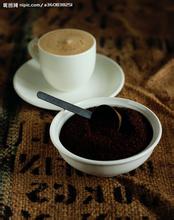The difference between small seed, medium seed and large seed of coffee how does the brand brew flavor describe the taste
The difference between small seed, medium seed and large seed of coffee how does the brand brew flavor describe the taste
Also known as Liberian species, evergreen trees. The plant is tall, more than 10 meters high, the branches are thick and hard, grow obliquely upward, and the branches cork the fastest. The leaf blade is oval or round, the leathery leaf surface is glossy, the leaf end is closed, and the leaf margin is not corrugated. The fruit is large, oblong, the skin and pulp are hard and thick, the navel is large and protruding. The ratio of fresh fruit to dried bean is about 7: 10. The seed shell is thick, hard and tough, the seed coat is close to the seed kernel, the bean grain is large, and there are about 1300 beans per jin. The ripe fruit is scarlet. The branches bear less fruit, and the number of fruits per node is about 5-6. The main root of this species is deep, drought-resistant, wind-resistant, cold-resistant, light-resistant, and most susceptible to rust. The yield per plant is high and the yield per unit area is low. Strong flavor and strong irritation.
The main varieties are Esselsa (also called Charley), which was introduced from Guangxi to Hainan in the 1970s. The fruit is vigorous, but the seed coat is thick and hard like a small seed, the ratio of fresh to dry is 5: 8, and the quality is strong and slightly bitter. Deep roots, strong drought and cold tolerance, resistance to leaf rust and longicorn beetles
The size of the particles depends on the variety of coffee beans, latitude, humidity, altitude, and so on. Due to different factors, the taste of coffee is different, some are bitter and light, some are heavy and bitter, some are mellow, some are sour, and so on, because countries around the world have different coffee drinking habits and coffee cultures. so you will choose different varieties of coffee.
Yunnan coffee belongs to the type of strong but not bitter, fragrant but not strong, and good sour taste, which is very suitable for Chinese taste.
The main producing areas of coffee in China are Hainan and Yunnan. Hainan mainly grows medium-grain coffee. Medium-grain coffee is a cross-pollinated crop, the genetic characters of its offspring are seriously varied and separated, and there is a great difference in yield, and low-yield trees account for a large proportion in the population of fruit trees. As early as 1935, Chen Xianzhang, an overseas Chinese from Guangdong, introduced medium-grain coffee from Java to be planted in Hainan. At present, most of the medium-grain coffee planted in production are unselected trees with low yield and poor efficiency. The clones with good medium-grain varieties can increase production by more than 40% compared with real trees. 1988-1993 The Flavor and Beverage Research Institute of the Chinese Academy of Tropical Agricultural Sciences has promoted the use of 8 clones in Longjun Farm, Xinglong overseas Chinese Farm, Chengmai County Hot farming Seedling Farm, Hongshan Farm and other places in Wanning County, Hainan Province. the area of low-yield garden is 1500 mu, and the survival rate of budding is more than 86%. The yield of coffee garden after budding is 2-3 times higher than that of coffee garden before budding. This technology has the advantages of low cost, quick effect and remarkable economic benefit.

Important Notice :
前街咖啡 FrontStreet Coffee has moved to new addredd:
FrontStreet Coffee Address: 315,Donghua East Road,GuangZhou
Tel:020 38364473
- Prev

Introduction to the method of Flower Butterfly Coffee Flavor description, texture Grinding and Calibration
Flower Butterfly single Coffee Flavor description Taste Grinding scale method Variety introduction has 40% Rose Summer high quality pedigree, composed of Rosa, Kaddura and Kaduai, planted in the Baru volcano region of Pokuit, growing in the volcanic area at an altitude of 1600 meters, the treatment plant uses fine water washing treatment, the special local microclimate of Panama leads to abundant rainfall in this area, and
- Next

Espresso step-manual espresso practice
Espresso step-manual espresso practice begins: first remove the brewing handle from the coffee machine. (need to pay attention to two things: first, always buckle the hand on the brewing head to keep warm, do not put it on the warm cup or plate or other places, otherwise the low temperature handle when brewing coffee will lower the temperature of the brewing water and cause the coffee to go sour. The coffee grounds inside are brewing the next cup of coffee.
Related
- What brand of black coffee is the most authentic and delicious? what are the characteristics of the flavor of the authentic Rose Summer Black Coffee?
- Introduction to the principle and characteristics of the correct use of mocha pot A detailed course of mocha pot brewing coffee is described in five steps.
- Which is better, decaf or regular coffee? how is decaf made?
- How much is a bag of four cat coffee?
- How about four Cat Coffee or Nestle Coffee? why is it a cheap scam?
- Which is better, Yunnan four Cats Coffee or Nestle Coffee? How about cat coffee? is it a fake scam? why is it so cheap?
- How about Cat Coffee? what grade is a hoax? which instant coffee tastes better, four Cat Coffee, Nestle Coffee or G7 coffee?
- Process flow chart of coffee making-Starbucks coffee making process what coffee tastes good at Starbucks
- The top ten best coffee beans in the world Rose summer coffee or Tanzanian coffee tastes good
- Yunnan four cat coffee is good to drink?_four cat coffee is a big brand? four cat blue mountain coffee is fake?

